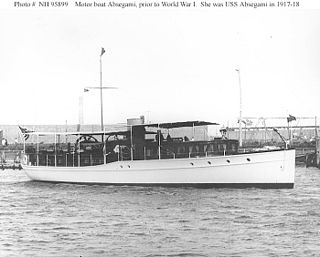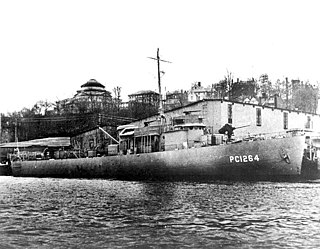
USS Underhill (DE-682) was a Buckley-class destroyer escort of the United States Navy during World War II. Built in 1943, she served in the Atlantic, the Mediterranean, and the Pacific until her sinking in a suicide attack by a Japanese Kaiten manned torpedo on 24 July 1945.

USS Absegami (SP-371) was a motorboat acquired on a free lease by the United States Navy during World War I. She was outfitted as an armed patrol craft and assigned to patrol the Delaware River from Philadelphia, Pennsylvania, to Cape May, New Jersey on the Delaware Bay. When the Navy found her excess to their needs, she was returned to her former owner.

USS PC-1264 was a PC-461-class submarine chaser built for the United States Navy during World War II. She was one of only two U.S. Navy ships to have a predominantly African-American enlisted complement during the war, the other being the Evarts-class destroyer escortUSS Mason.

A submarine chaser or subchaser is a small naval vessel that is specifically intended for anti-submarine warfare. Many of the American submarine chasers used in World War I found their way to Allied nations by way of Lend-Lease in World War II.

USS Isabel (SP-521), later PY-10, was a yacht in commission in the United States Navy as a destroyer from 1917 to 1920 and as a patrol yacht from 1921 to 1946.

USS Bridgeport (AD-10/ID-3009) was a destroyer tender in the United States Navy during World War I and the years after. She was a twin-screw, steel-hulled passenger and cargo steamship built in 1901 at Vegesack, Germany as SS Breslau of the North German Lloyd line. Breslau was one of the seven ships of the Köln class of ships built for the Bremen to Baltimore and Galveston route.

USS Wadena (SP-158) was a converted yacht patrol vessel of the United States Navy during World War I. She was built in 1891 in Cleveland, Ohio, as a steam yacht for Jeptha Homer Wade II of Cleveland and New York City. During her Navy career, Wadena made several trips escorting submarine chasers across the Atlantic Ocean, and, later, patrolling in the Atlantic and Mediterranean. on 26 February 1918 Wadena came to the aid of sinking tug Mariner and rescued all of her crew.
USS SC-255, sometimes styled as either Submarine Chaser No. 255 or S.C.-255, was an SC-1-class submarine chaser built for the United States Navy during World War I. Like most members of her class, she was not named and known only by her designation.
USS SC-142, sometimes styled as either Submarine Chaser No. 142 or S.C.-142, was an SC-1-class submarine chaser built for the United States Navy during World War I. Upon completion, she was transferred to the French Navy

USS SC-48, sometimes styled as either Submarine Chaser No. 48 or S.C.-48, was an SC-1-class submarine chaser built for the United States Navy during World War I. Like most members of her class, she was not named and known only by her designation.

USS Dreadnaught (ID-1951), later YT-534 and YNG-21, was a United States Navy tug that was in service from 1918 to 1944.

The PCE-842-class patrol craft were United States Navy patrol craft escorts designed during World War II that were intended for coastal and convoy escort. The design was derived from the 180-foot (55 m) Admirable-class minesweeper as a substitute for the 173-foot (53 m) PC-461-class submarine chasers that were used for anti-submarine warfare (ASW) in coastal areas. At 185 feet long and 640 tons, the PCE is more than twice the displacement of the PC and thus and in combination with a less powerful engine also much slower. It has a crew complement of 99 officers and men.

The USS PC-598 was a 173ft metal hulled PC-461-class submarine chaser in the United States Navy. The submarine chaser fought in the Pacific Theatre during World War II, and was converted to an amphibious landing control vessel during the war, reclassified as a Patrol Craft-Control (PCC). It participated in six amphibious invasions as a control vessel during the war.










